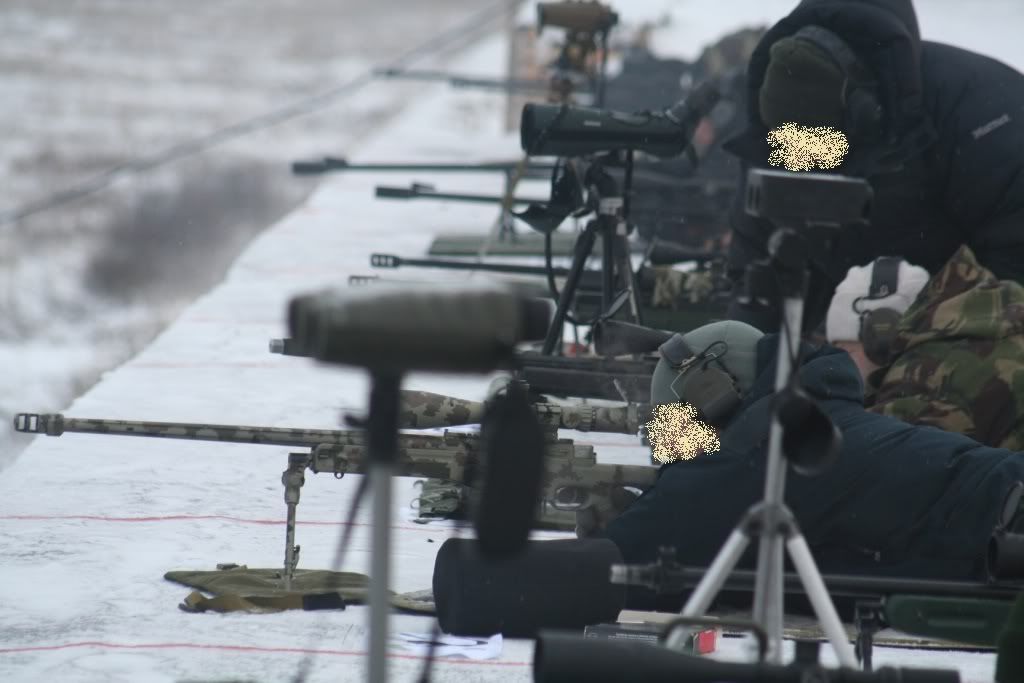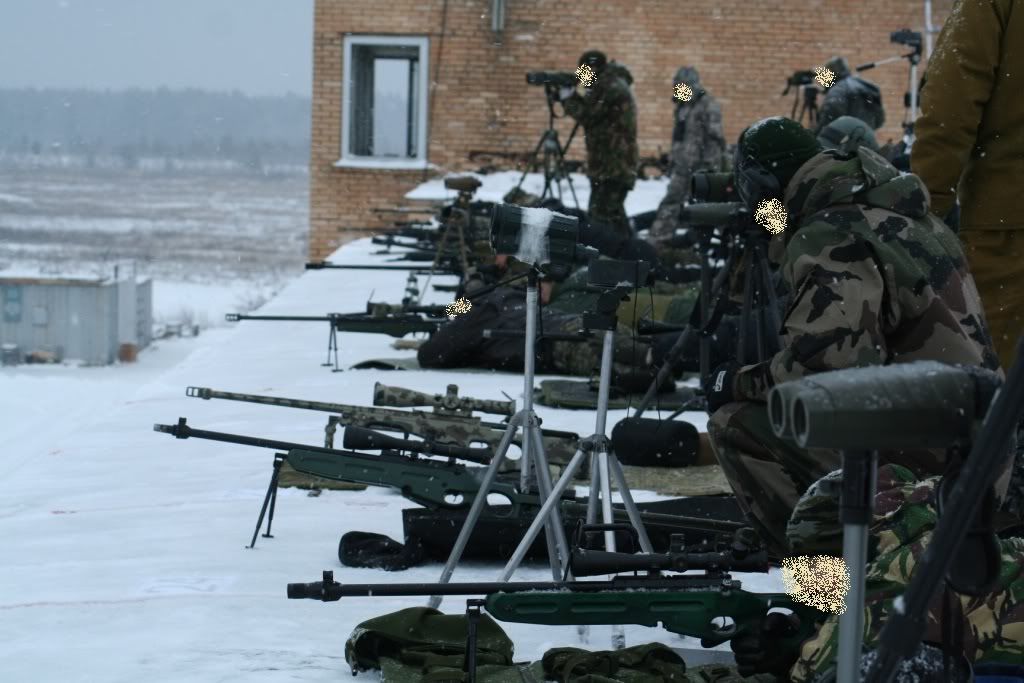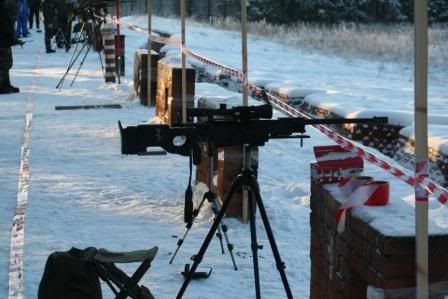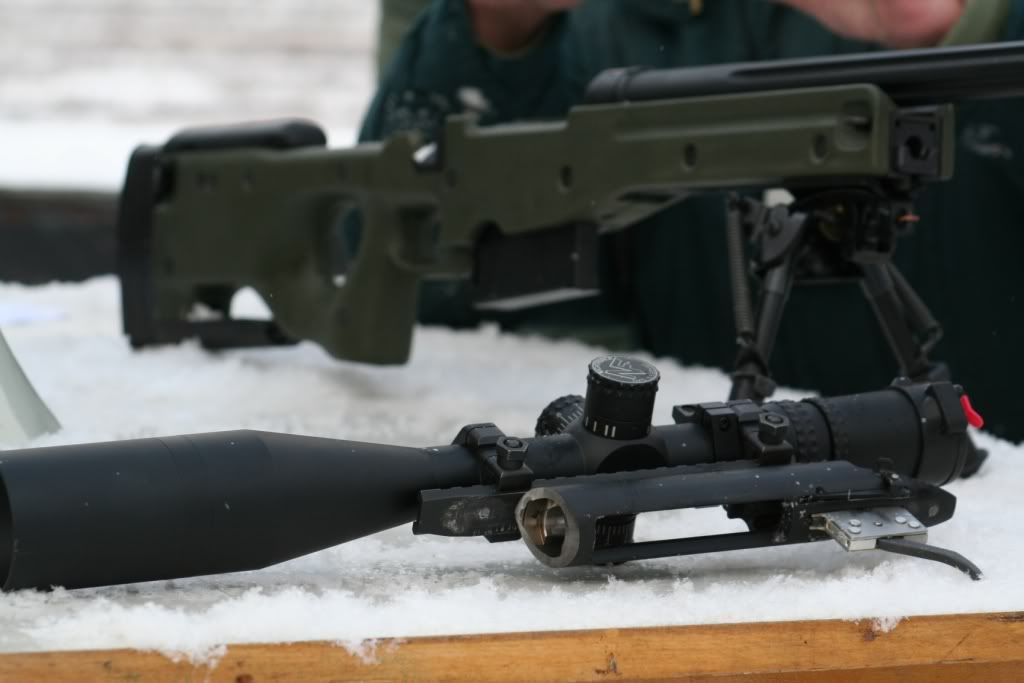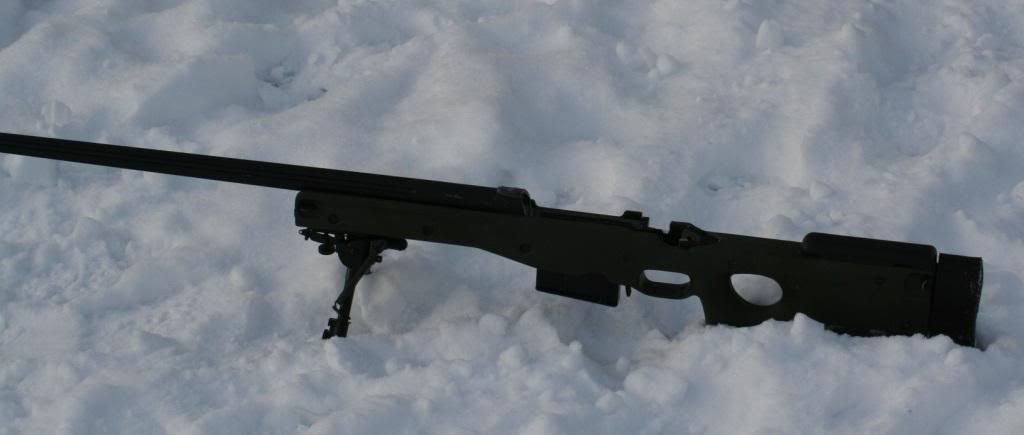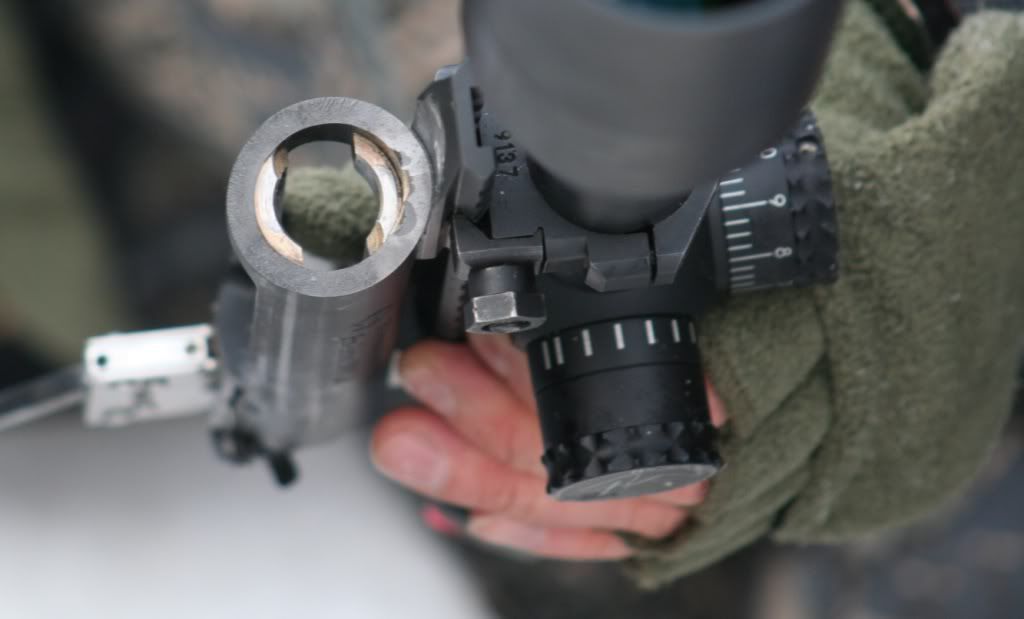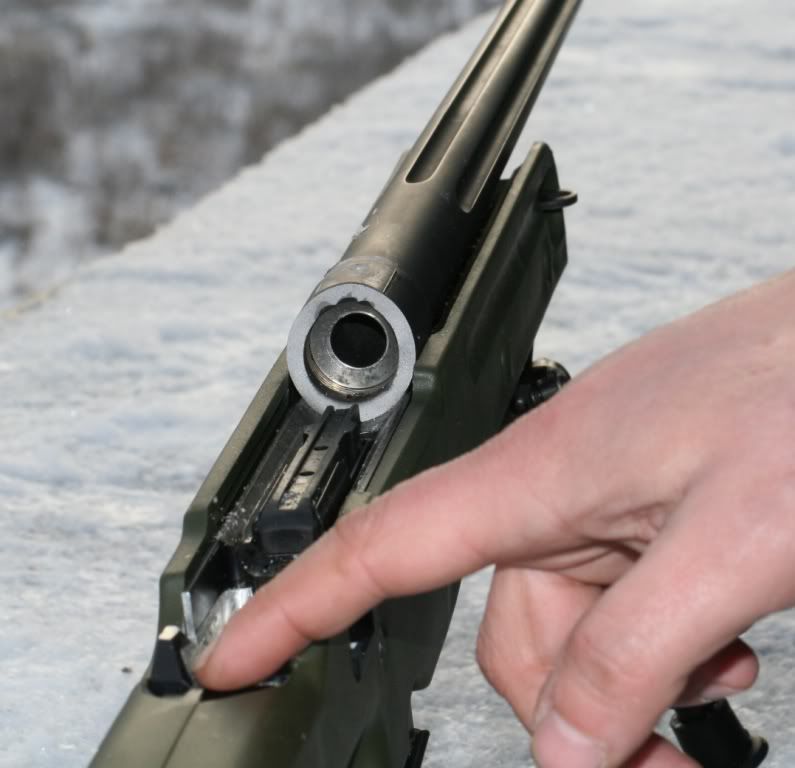Re: Great problem with the H-S Precision rifle.
<div class="ubbcode-block"><div class="ubbcode-header">Originally Posted By: okiefired</div><div class="ubbcode-body"><div class="ubbcode-block"><div class="ubbcode-header">Originally Posted By: layinclose2hell</div><div class="ubbcode-body"> however this case would be the first time I have ever seen a compromise that moved backwards 1 full centimeter thru all of the resistance and have a beautifully clean fracture. </div></div>
This statement makes me wonder if you have any idea what you are talking about. I have seen hundreds of sheared bolts that did absolutely NO damage to the hole or the threads and I literally removed what was left of the bolts with my fingers. If the reciever itself was flawed, the only thing that was a "beutifully cleaned fracture" was a few small hard bolts of which you thought earlier was a filled in hole. With the forces applied in the chamber of a .338, those bolts (ie: reciever to stock and scope base) would be absolutely nothing to shear in a very clean break if the reciever itself was comprimised.
okie </div></div>
Sheared bolts are a different animal altogether. Highbinder makes a very valid point. I do not believe it is shear at work, and there may definitely be a metal failure due to inconsistencies or flaws. I am not debating these facts. What I am saying is that the supplemental areas offered resistance, and if there was resistance for even a millisecond, the reactive force will attempt to dissipate in another direction before moving backwards, thus exposing a metallurgic flaw. The pressures involved could have compounded over time, and caused this unique reaction, that is true. Once again, I am looking forward to seeing the results of HS Precisions tests on the metal, because it will eliminate all variables that we are debating with scientific fact. I believe it is unrealistic to not take into account all of the other variables at work here, because I am sure that HS Precision will scrutinize the evidence, and determine if other receivers are also affected, or if it was a compound of issues that caused the failures. Let’s wait to hear.
And for the record, here is the reactive information for hardware utilized for attaching:
ASTM, SAE AND ISO GRADE MARKINGS AND MECHANICAL PROPERTIES FOR STEEL FASTENERS
Identification
Grade Mark Specification Fastener
Description Material Nominal Size
Range (in.) Mechanical Properties
Proof Load
(psi) Yield Strength
Min (psi) Tensile Strength
Min (psi)
No
Grade
Mark SAE J429
Grade 1 Bolts,
Screws,
Studs Low or Medium Carbon Steel 1/4 thru 1-1/2 33,000 36,000 60,000
ASTM A307
Grades A&B Low Carbon Steel 1/4 thru 4 -- --
SAE J429
Grade 2 Low or Medium Carbon Steel 1/4 thru 3/4 Over 3/4 to 1-1/2 55,000
33,000 57,000
36,000 74,000
60,000
No
Grade
Mark SAE J429
Grade 4 Studs Medium Carbon Cold Drawn Steel 1/4 thru 1-1/2 -- 100,000 115,000
B5 ASTM A193
Grade B5 AISI 501 1/4 Thru 4 -- 80,000 100,000
B6 ASTM A193
Grade B6 AISI 410 85,000 110,000
B7 ASTM A193
Grade B7 AISI 4140, 4142, OR 4105 1/4 thru 2-1/2
Over 2-1/2 thru 4
Over 4 thru 7 --
--
-- 105,000
95,000
75,000 125,000
115,000
100,000
B16 ASTM A193
Grade B16 CrMoVa Alloy Steel 105,000
95,000
85,000 125,000
115,000
100,000
B8 ASTM A193
Grade B8 AISI 304 1/4 and larger -- 30,000 75,000
B8C ASTM A193
Grade B8C AISI 347
B8M ASTM A193
Grade B8M AISI 316
B8T ASTM A193
Grade B8T Bolts,
Screws,
Studs for High-Temperature Service AISI 321 1/4 and larger -- 30,000 75,000
B8 ASTM A193
Grade B8 AISI 304
Strain Hardened 1/4 thr 3/4
Over 3/4 thru 1
Over 1 thru 1-1/4
Over 1-1/4 thru 1-1/2 --
--
--
-- 100,000
80,000
65,000
50,000 125,000
115,000
105,000
100,000
B8C ASTM A193
Grade B8C AISI 347
Strain Hardened
B8M ASTM A193
Grade B8M AISI 316
Strain Hardened 95,000
80,000
65,000
50,000 110,000
100,000
95,000
90,000
B8T ASTM A193
Grade B8T AISI 321
Strain Hardened 100,000
80,000
65,000
50,000 125,000
115,000
105,000
100,000
L7 ASTM A320
Grade L7 Bolts,
Screws,
Studs for Low-Temperature Service AISI 4140,
4142 or 4145 1/4 thru 2-1/2 -- 105,000 125,000
L7A ASTM A320
Grade L7A AISI 4037
L7B ASTM A320
Grade L7B AISI 4137
L7C ASTM A320
Grade LC7 AISI 8740
L43 ASTM A320
Grade L43 AISI 4340 1/4 thru 4 -- 105,000 125,000
B8 ASTM A320
Grade B8 Bolts,
Screws,
Studs for Low-Temperature Service AISI 304 1/4 and larger -- 30,000 75,000
B8C ASTM A320
Grade B8C AISI 347
B8T ASTM A320
Grade B8T AISI 321
B8F ASTM A320
Grade B8F AISI 303
or 303Se
B8M ASTM A320
Grade B8M AISI 316
B8 ASTM A320
Grade B8 AISI 304 1/4 thru 3/4
Over 3/4 thru 1
Over 1 thru 1-1/4
Over 1-1/4 thru 1-1/2 --
--
--
-- 100,000
80,000
65,00
50,00 100,000
80,000
65,00
50,00
B8C ASTM A320
Grade B8C AISI 347
B8F ASTM A320
Grade B8F AISI 303
or 303Se
B8M ASTM A320
Grade B8M AISI 316
B8T ASTM A320
Grade B8T AISI 321
SAE J429
Grade 5 Bolts,
Screws,
Studs Medium Carbon Steel, Quenched and Tempered 1/4 thru 1
Over 1 to 1-1/2 85,000
74,000 92,000
81,000 120,000
105,000
ASTM A449 1/4 thru 1
Over 1 to 1-1/2
Over 1-1/2 thru 3 85,000
74,000
55,000 92,000
81,000
58,000 120,000
105,000
90,000
SAE J429
Grade 5.1 Sems Low or Medium Carbon Steel, Quenched and Tempered No. 6
thru 3/8 85,000 -- 120,000
SAE J429
Grade 5.2 Bolts,
Screws,
Studs Low Carbon Martensitic Steel, Quenched and Tempered 1/4 thru 1 85,000 92,000 120,000
A325 ASTM A325
Type 1 High Strength
Structural Bolts Medium Carbon Steel, Quenched and Tempered 1/2 thru 1
1-1/8 thru 1-1/2 85,000
74,000 92,000
81,000 120,000
105,000
A325 ASTM A325
Type 2 Low Carbon Martensitic Steel, Quenched and Tempered 1/2 thru 1 85,000 92,000 120,000
A325 ASTM A325
Type 3 Atmospheric Corrosion Resisting Steel, Quenched and Tempered 1/2 thru 1
1-1/8 thru 1-1/2 85,000
74,000 92,000
81,000 120,000
105,000
BB ASTM A354
Grade BB Bolts,
Studs Alloy Steel, Quenched and Tempered 1/4 thru 2-1/2
2-3/4 thru 4 80,000
75,000 83,000
78,000 105,000
100,000
BC ASTM A354
Grade BC 105,000
95,000 109,000
99,000 125,000
115,000
SAE J429
Grade 7 Bolts,
Screws, Medium Carbon Alloy Steel, Quenched and Tempered 4 1/4 thru 1-1/2 105,000 115,000 133,000
SAE J429
Grade 8 Bolts,
Screws,
Studs Medium Carbon Alloy Steel, Quenched and Tempered 1/4 thru 1-1/2 120,000 130,000 150,000
ASTM A354
Grade BD Alloy Steel, Quenched and Tempered 4
No Grade
Mark SAE J429
Grade 8.1 Studs Medium Carbon Alloy or SAE 1041 Modified Elevated Temperature Drawn Steel 1/4 thru 1-1/2 120,000 130,000 150,000
A490 ASTM A490 High Strength Structural Bolts Alloy Steel, Quenched and Tempered 1/2 thru 1-1/2 120,000 130,000 150,000 min
170,000 max
No Grade
Mark ISO R898
Class 4.6 Bolts,
Screws,
Studs Medium Carbon Steel, Quenched and Tempered All Sizes
thru 1-1/2 33,000 36,000 60,000
No Grade
Mark ISO R898
Class 5.8 55,000 57,000 74,000
8.8
or
88 ISO R898
Class 8.8 Alloy Steel, Quenched and Tempered 85,000 92,000 120,000
10.9
or
109 ISO R898
Class 10.9 120,000 130,000 150,000
FASTENER IDENTIFICATION MARKING
Grade
Identification
Marking Specification Material Nominal Size
In. Proof
Load
Stress
ksi Hardness
Rockwell See
Note
Min Max
No Mark ASTM A563 - Grade 0 Carbon Steel 1/4 thru 1-1/2 69 B55 C32 3,4
ASTM A563 - Grade A Carbon Steel 1/4 thru 1-1/2 90 B68 C32 3,4
ASTM A563 - Grade B Carbon Steel 1/4 thru 1 120 B69 C32 3,4
over 1 thru 1-1/2 105
ASTM A563 - Grade C Carbon Steel
May be Quenched
and Tampered 1/4 thru 4 144 B78 C38 5
ASTM A563 - Grade C3 Atmospheric
Corrosion
Resistant Steel
May be Quenched
and Tampered 1/4 thru 4 144 B78 C38 5,9
ASTM A563 - Grade D Carbon Steel
May be Quenched
and Tampered 1/4 thru 4 150 B84 C38 6
ASTM A563 - Grade DH Carbon Steel
Quenched
and Tampered 1/4 thru 4 175 C24 C38 6
ASTM A563 - Grade DH3 Atmospheric
Corrosion
Resistant Steel,
Quenched
and Tampered 1/4 thru 4 175 C24 C38 5,9
ASTM A194 - Grade 1 Carbon Steel 1/4 thru 4 130 B70 -- 7
ASTM A194 - Grade 2 Medium Carbon
Steel 1/4 thru 4 150 159 352 7,8
ASTM A194 - Grade 2H Medium Carbon
Steel, Quenched
and Tempered 1/4 thru 4 175 C24 C38 7
ASTM A194 - Grade 2HM Medium Carbon
Steel, Quenched
and Tempered 1/4 thru 4 150 159 237 7,8
ASTM A194 - Grade 4 Medium Carbon
Alloy Steel,
Quenched
and Tempered 1/4 thru 4 175 C24 C38 7
ASTM A194 - Grade 7 Medium Carbon
Alloy Steel,
Quenched
and Tempered 1/4 thru 4 175 C24 C38 7
ASTM A194 - Grade 7M Medium Carbon
Alloy Steel,
Quenched
and Tempered 1/4 thru 4 150 159 237 7
See Note 1,2 10
NOTES:
In addition to the indicated grade marking, all grades, except A563 grades O, A and B, must be marked for manufacturer identification.
The markings shown for all grades of A194 nuts are for cold formed and hot forged nuts. When nuts are machined from bar stock the nut must be additionally marked with the letter 'B'.
Nuts are not required to be marked unless specified by the purchaser. When marked, the identification marking shall be the grade letter O, A or B.
Properties shown are those of nonplated or noncoated coarse thread hex nuts.
Properties shown are those of coarse thread heavy hex nuts.
Properties shown are those of coarse thread heavy hex nuts.
Properties shown are those of coarse 8-pitch thread heavy hex nuts.
Hardnesses are Brinell Hardness Numbers.
The nut manufacturer, at his option, may add other markings to indicate the use of atmospheric corrosion resistant steel.
Specifications --
ASTM A563 -- Carbon and Alloy Steel Nuts.
ASTM A194/A194M -- Carbon and Alloy Steel Nuts for Bolts for High Pressure and High Temperature Service.



